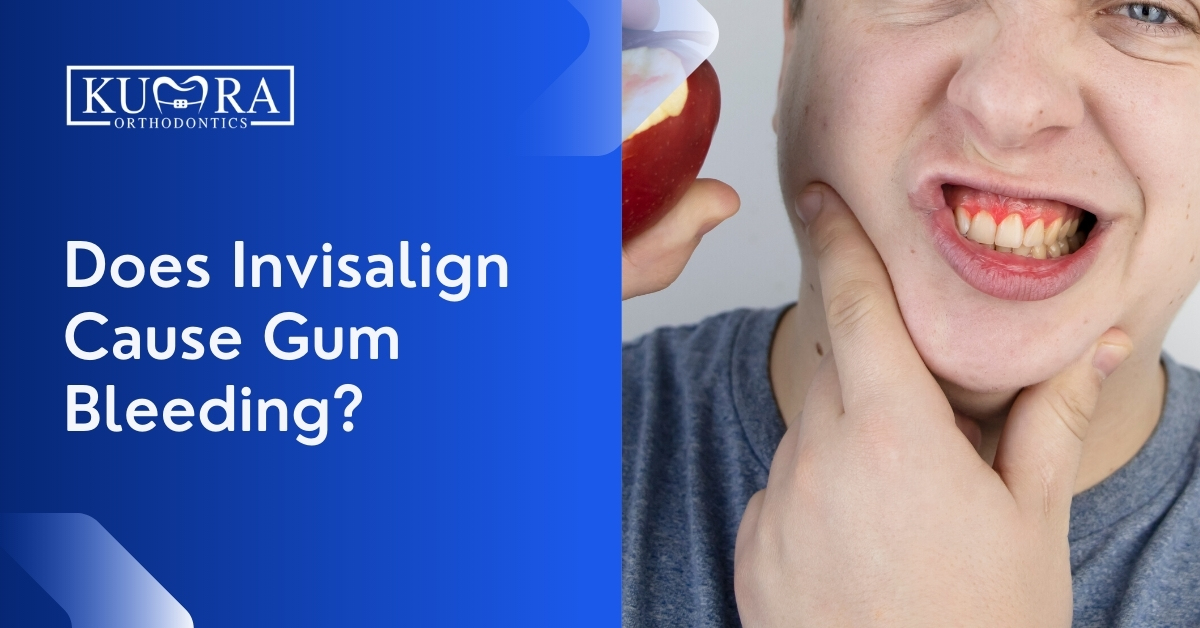Invisalign is known to cause mild gum bleeding and inflammation in the first few days of use. This is to be expected as gum tissue movement can increase sensitivity and induce bleeding in the area where it is occurring.
If you notice that your gums are bleeding, you should make an appointment with your orthodontist. They will be able to determine if the bleeding is due to the Invisalign and give you advice on how to proceed.
In this article, we’ll look at how Invisalign affects your gums and how likely it is that you’ll experience bleeding gums if you choose this type of orthodontic treatment.
What is Invisalign?
Invisalign is a type of clear orthodontic aligner that is used to straighten teeth. It is an increasingly popular option for adults who want to improve their smile but don’t want to wear traditional metal braces. One of the main advantages of Invisalign over other orthodontic options is that the aligners are nearly invisible when worn, so they are much less noticeable than metal braces.
How does Invisalign work?
With Invisalign, your dentist creates clear aligners based on computer-generated photographs of your mouth and imprints taken from the inside of your mouth. The Invisalign system uses a succession of molds to shift your teeth into their new and improved position gradually. This is extremely different from traditional braces that use a fixed wire to pull teeth into alignment.
Read More: How Does Invisalign Work and What are Its Limitations?
7 Common Causes of Bleeding Gums
Gums may bleed because of the following:
- Have gingivitis, an infection of the gums that results in swelling and pain.
- Over- or under-brushing could lead to tooth decay and gum disease.
- When it comes to flossing, your gums may not be adjusted to the new practice yet.
- Take blood-thinning drugs, such as warfarin.
- Because you’re pregnant, you have swollen gums (pregnancy gingivitis)
- Having trouble with your dentures
- Defective restorative dental work
Fortunately, bleeding gums and gum recession can be prevented from worsening and necessitating invasive treatment if detected and treated in time.
Can Invisalign make gums bleed?
Moderate gum bleeding and inflammation are to be expected when using clear aligners, especially during the first few days of use. Extra sensitivity and bleeding can be caused by gum tissue movement in the afflicted area. Some mouth surfaces may also be scratched and cut by the edges of the trays, which causes the gums to bleed.
It can take some time for the gums to adjust to the new location of a tooth when the teeth move, so it’s important to be patient. If you do suffer bleeding while wearing the aligners, you should know that it normally subsides over the course of a few days as the gums adapt. If the bleeding persists or worsens, make an appointment with your orthodontist straight soon.
Needing an orthodontic appointment?
Visit Kumra Orthodontics Washington, DC or Kumra Orthodontics Stafford, VA, and request an appointment with us!
4 Tips to Treat Invisalign Bleeding Gums
Invisalign gum bleeding can be uncomfortable, but following these measures will make you more at ease and help you cope with the problem.
Brush your teeth softly but frequently.
Even if your gums are sore and bleeding, you must follow your orthodontist’s advice and maintain brushing as prescribed. If you don’t, you risk developing gingivitis, which can lead to bleeding gums and more serious symptoms, such as tooth loss. It’s also a good idea not to brush too hard. Don’t over-brush your gums, as this might cause bleeding and pain to worsen.
Use a brush with a softer bristle.
For best results, brush with a softer toothbrush. A soft-bristled toothbrush will help you avoid damaging your gums while you brush. Be sure to brush gently and use circular motions, and don’t forget to brush your tongue, too! Doing all of these things will help keep your mouth healthy and free from bacteria.
It’s possible that an electric toothbrush may be a better option for you also. These toothbrushes include unique brush heads that make it easier to clean your gums than a manual toothbrush.
Thoroughly rinse and clean your aligners.
It’s important to thoroughly rinse and clean your aligners. Food particles and bacteria can build up on them, which can irritate your gums and cause inflammation. Be sure to brush them with a soft-bristled toothbrush and lukewarm water at least once a day. You should also soak them in denture cleaning solution overnight once a week.
Eat softer food.
Eating softer food will help reduce the amount of friction on your gums and will also make it easier to clean your teeth afterwards. Some good food choices include yogurt, cottage cheese, soup, cooked pasta, soft fruits like bananas or melon, and mashed potatoes. If you need help finding other soft foods to eat, ask your dentist or orthodontist for suggestions.
Consult with Kumra Orthodontics to Learn More about Whether Is It Normal for Gums to Bleed with Invisalign
Bleeding gums is a common side effect for many people who get Invisalign. However, it’s not something to worry about – as long as you take good care of your teeth and gums. Consult with Kumra Orthodontics to learn more about how to keep your smile healthy during treatment and after your braces come off. We can help you make sure that the benefits of Invisalign outweigh any potential risks so that you can feel confident in your choice!



